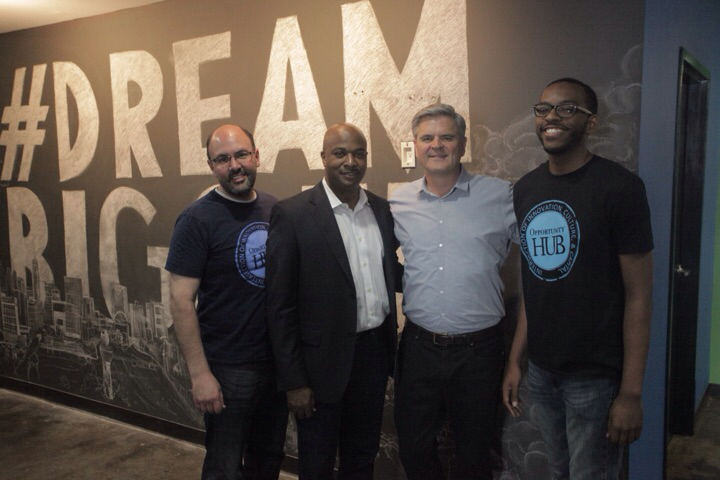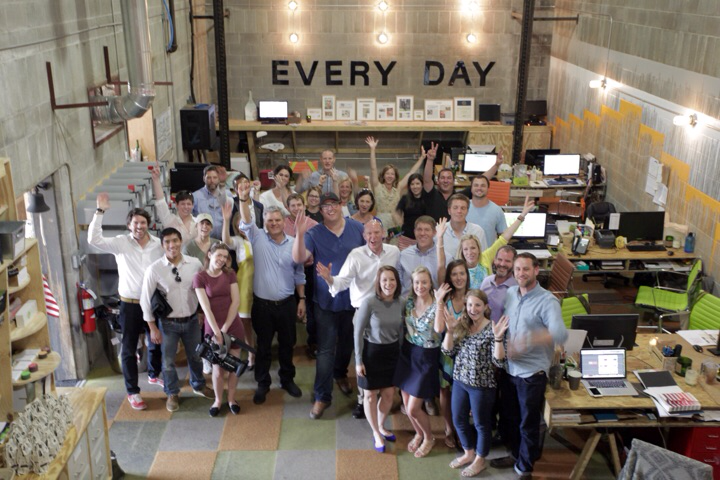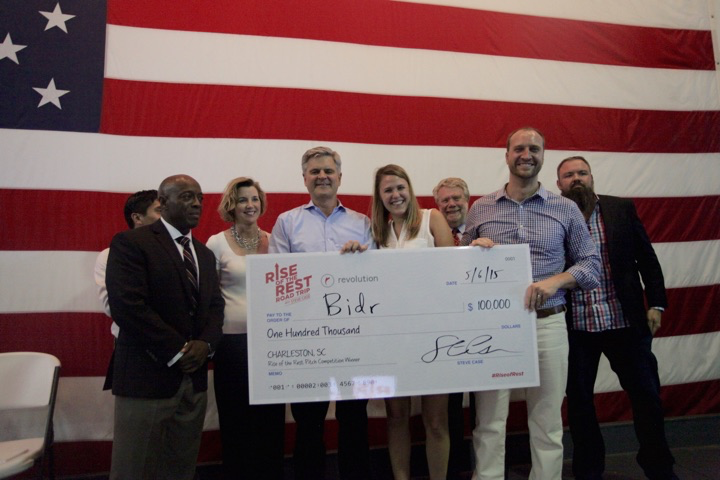Committee on the Judiciary
Hearing
“The PATENT Act: Finding Effective Solutions to Abusive Patent Litigation”
Testimony of Julie P. Samuels
Executive Director and President of the Board,
Engine
May 7, 2015
Chairman Grassley, Ranking Member Leahy, and members of the Committee, thank you for holding this hearing and inviting me to testify about finding effective solutions to abusive patent litigation. We are greatly encouraged by all your committee has done to address the problem of abusive litigation practices, a favorite weapon of so-called patent trolls.
I am the Executive Director and President of the Board of Engine, a technology policy, research, and advocacy organization that bridges the gap between policymakers and startups. To accomplish this, we work with government and a community of hundreds of high-technology, growth-oriented startups across the nation to support the development of technology entrepreneurship. Engine creates an environment where technological innovation and entrepreneurship thrive by providing knowledge about the startup economy and helping to construct smarter public policy. To that end, Engine conducts research, organizes events, and spearheads campaigns to educate elected officials, the entrepreneur community, and the general public on issues vital to fostering technological innovation.
Patent litigation abuse is a real problem, and one that disproportionately targets the startups and small businesses that make up Engine’s community. This troll problem is an acute and growing menace that adversely impacts the operations and viability of companies who can least afford these threats. Since startups and small businesses are key drivers of innovation and job growth, troll threats against them are particularly stifling to American economic growth and prosperity. One recent study found that trolls cost the U.S. economy at least $29 billion per year.
As a preliminary matter, I use the colloquial term “patent troll” or “troll” throughout this testimony for ease of description, but titles and terminology are immaterial. The parties who have created the problem and continue to abuse the system use certain behaviors that should not be permissible under the law; it is these behaviors the PATENT Act rightfully targets.
Background
Trolls exploit poor quality patents and a litigation system that is stacked in their favor to extract nuisance settlements from vulnerable startups, typically with baseless claims. They hide behind shell companies in order to exploit uncertainty about patent ownership and ambiguity about what their patents purport to cover. Without any due diligence, they routinely send demand letters and file suit alleging infringement to multiple parties, on a wholesale and indiscriminate basis, demanding settlement payments from their innocent prey. Trolls have also been known to even target a company’s customers, in an effort to extort quick settlements that would otherwise not be warranted. The troll abuse problem is exacerbated by the fact that trolls amass and deploy poor quality patents—vague, abstract, or overly broad patents that fail to meet the law’s requirements that were erroneously issued in the first place.
This chokehold on innovation requires a multi-pronged set of remedies; the courts, the Patent and Trademark Office (PTO), and Congress each must play an essential role. The Supreme Court has taken significant steps on the judicial front, issuing several key decisions that clarify and strengthen patent quality, particularly the requirements for patent eligibility. If rigorously implemented by the PTO and by other courts, these decisions should have the effect of improving the quality of prospective patents. However, the decisions will have little impact on the many existing patents in trolls’ arsenals and on a litigation system that is unbalanced and unfair. And patent allowances show no sign of slowing: the rates of allowance are alarmingly high at 92 percent in 2014 (up from below 70 percent just five years ago). That means that 322,214 patents were issued in 2014 alone.
Thus, patent quality is but one side of the troll equation. Trolls thrive because of a grossly uneven patent litigation playing field that incentivizes and rewards frivolous claims. Only legislation can change that. We need a robust reform bill, like the PATENT Act, to give startups, small businesses, and even individuals a fair chance to have their day in court when faced with a troll threat. Unless these reforms are enacted, patent trolls will continue forcing startups to drain critical energy and resources away from the business of innovating and creating jobs.
The Impact on Startups
Startups and small businesses develop breakthrough technologies that fuel innovation and drive economic growth and job creation. In fact, research shows that startups are responsible for all net new job growth in the United States. So trolls’ crushing impact on startups reverberates throughout the ecosystem, impeding innovation and hurting the U.S. economy at large.
Research also shows that startups bear the brunt of troll abuse and the impact of troll threats on startups is disproportionately severe: 82 percent of troll activity targets small and medium-sized businesses, and 55 percent of troll suits are filed against companies with revenues of less than $10 million. Generally lacking the resources to decipher vague and often bogus demand letters, startups are vulnerable to extortion. The time and money required to fight back against a troll could put the viability of their entire business in jeopardy.
Trolls’ impact on startup operations is acute: a very high percentage of startups who received a demand letter reported “significant operational impact” in the form of deferred hiring, change in strategy, cost-cutting, reductions in personnel, decreased valuation or total shut-down.
The economic incentives in the troll model are clear: a bare bones and vague demand letter provides immediate low-risk, low-cost leverage over a startup, even when the claim is baseless. It can easily cost a startup $50,000 just to hire a patent lawyer to evaluate demand letter claims. Litigation costs range between $1 million and $6 million, and can mean life or death for a fledgling business. So startups often capitulate, and layoff an employee or hire one less programmer, in order to pay off the troll. For example, Ditto, a virtual eyewear company, had to lay off four of its 15 employees in response to a troll demand. Although the infringement claim was dismissed, the suit resulted in a reduction in Ditto’s valuation of $4 million.
The mere threat of troll suits has chilling effects on the investment community. In a survey of 200 venture capitalists, 100 percent indicated that the presence of a patent demand could be a major deterrent in deciding whether to invest. It is estimated that VC investment in startups would have been $8 billion higher but for troll threats in the last five years alone.
Trolls like to paint themselves as the champions of the small guys, as legitimate entities who help independent inventors monetize their patents by enforcing them on the inventor’s behalf. In fact, trolls increasingly target small entities, and statistics show that very little of a patent troll’s revenue is transferred to actual inventors. Patent trolling activities are associated with half a trillion dollars of lost wealth for their victims—largely startups and small businesses—from 1990 to 2010 alone.
Patent trolls are primarily armed with two weapons: low-quality, impossible-to-understand patents and the outrageous costs of patent litigation, which can easily run well into the millions of dollars. So imagine you are a small startup, cash-strapped and hungry, and you get a patent demand, either in the form of a lawsuit or a demand letter, from a company you’ve never heard of, claiming it owns some seemingly basic technology. Your choices are: hire a lawyer and spend valuable time dealing with the problem or pay the troll to go away, usually for a sum far smaller than what it would cost to hire that lawyer or go to court.
And while numbers and statistics can feel abstract, the impact that trolls have on real startups and entrepreneurs is extremely personal. Take the experience of Jump Rope, a Chicago startup founded by Peter Braxton. An Air Force veteran and former Combat Pilot, Braxton started Jump Rope using his own money and funds raised from friends and family. Jump Rope is a smartphone application where users can pay a (dynamic) price to skip the line and gain immediate entrance to nightclubs, bars, museums, and sporting events. The platform provides a time-saving, transparent and hassle-free service to its customers.
Less than one month after launching Jump Rope, a patent troll called Smart Options approached Braxton, claiming that Jump Rope infringed its patent. Braxton’s lawyers advised him to settle, be he instead decided to fund the litigation personally–spending more than $250,000. Braxton won the first suit, and the court awarded him fees after a finding that the Smart Options failed to perform even minimal due diligence before suing. Nevertheless, Smart Options came back, threatening additional suits with even more patents. The situation took a surprising turn when Erich Spangenberg, often called a patent troll himself, agreed to step in to fund Jump Rope’s defense in exchange for equity in the business. In the end, Braxton was forced to give up sizeable equity in his business in order to fight what proved to be specious claims.
These kinds of troll stories are all too common. There’s the case of TMSoft, creator of a popular white noise app, which was targeted by now notorious troll Lodsys. Lodsys was a particularly destructive troll, targeting app developers for implementing simple click-to-upgrade functionality, a basic technology that both Apple and Google provide to their app sellers. TMSoft founder Todd Moore was forced to defend his company, knowing that litigation could cost millions of dollars he didn’t have. But he still rejected Lodsys’ offer of a $3,500 settlement that would be routed to an overseas bank account. Fortunately, Lodsys decided to drop the case before it went to trial. But Moore’s attorney estimates the case required legal work that was valued at $190,000 - even though it never even made it to a courtroom.
Another California company, Life360, also found itself in the crosshairs of a patent troll. Life360’s app keeps over 55 million families safe and connected through messaging and location sharing capabilities. The company had on several occasions chosen to settle with patent trolls. But after growing their network to millions of families and raising $50 million in capital early last year, the company was hit with a troll suit that it decided to fight head on. The troll in question was Florida-based Advanced Ground Information Systems, or AGIS. AGIS claimed that its patent covered any tech that marks the location of a person on a map and makes calls to that person’s phone.
Life360 took the case to a jury trial where it won a verdict of non-infringement on all counts. Yet in spite of a jury finding the troll’s claims meritless, Life360 still had to spend over $1.5 million to defend itself, with no reasonable recourse to recover that money. That’s $1.5 million that could have paid salaries for additional jobs, instead spent defending against a baseless lawsuit.
These are the kinds of consequences that result from troll suits, not just for brand new ventures but for growing startups as well. Foursquare currently faces four separate troll suits, on top of two it has already settled. Its legal budget this year set aside a sum of money for these cases that would otherwise have been enough to hire between six and ten additional engineers—good jobs that now do not exist. Foursquare is itself a patent holder, and believes in a strong patent system. But this constant onslaught of troll attacks have prompted companies like Foursquare to support comprehensive patent reform like the PATENT Act.
Unfortunately, many startups are so afraid of attracting more troll suits that they are willing to share their stories only if their names are omitted. One such company, a California-based startup, has been faced multiple meritless suits from patent trolls. The startup’s general counsel reported: “The system is set up in such a way that it pretty much guarantees that the troll gets paid. It has nothing to do with the patent’s claims, but with the litigation fees. We were bombarded with letters, emails, discovery requests, and motions. It was all meaningless paper, but we still had to spend time and money to respond.” In spite of these continued attacks, this startup recently filed for its first patent and plans to file more applications in the future. It also strongly supports litigation reforms like those included in the PATENT Act. To quote its general counsel: “As an actual innovator, we believe in patenting our inventions. But we still support reform efforts aimed at those who abuse the patent litigation system.”
Another California-based startup that asked to remain anonymous spends between $800,000 and $1 million annually developing its patent portfolio, which the company generally intends to use for defensive purposes. This company’s general counsel pointed out that this money—which could be used to innovate, fund growth or hire more employees—is instead being used just to protect against lawsuits. He also told me that “the way the current system is set up today stifles innovation. People holding large patent portfolios with no intent to practice the inventions hinder innovation. You can’t go forward and do something without the fear of a lawsuit. It’s inconceivable to get an effective freedom to operate opinion because there are so many existing patents out there and new ones filed everyday on questionable so-called ‘new inventions’.”
This particular company, which employs nearly 400 people nationwide, has faced several troll suits from traditional trolls and so-called competitors with “licensing programs.” One such competitor signed up for the company’s service online, and then filed patents for the type of services provided, without citing the original company’s work as prior art in its patent application. That so-called competitor went on to sue, and the original company had to settle to avoid the costs of litigation. These cases illustrate why there is no need to define who is or who is not a patent troll—legislation like the PATENT Act need only target certain bad-faith behaviors that attempt to substitute litigation for innovation.
The PATENT Act Includes Necessary Reforms
Only legislation can deter trolls from exploiting a stacked litigation deck against startups like those discussed above to extort settlements. Congress must therefore pass the PATENT Act, a strong patent reform bill that removes existing incentives to assert bad patents and creates a level litigation playing field for all inventors. Specifically:
- Because trolls often hide behind shell companies, the PATENT Act requires transparency of a patent’s ownership so startups know exactly who is threatening them, can access information about whom else a troll may be suing with the same patent, and can better evaluate how to respond.
- Because someone can file a patent suit without providing almost any basic details about his or her case, information like how a patent is infringed, what products allegedly infringe it, and even who owns that patent, the PATENT Act institutes welcome increased transparency requiring this type of information. This information is easily known to any patent holder at the outset of a case, especially those who engage in a responsible amount of due diligence prior to filing a case. Yet startups are left with no choice but to consult a lawyer about the scope of the threat they face. However, most startups don’t have an in-house lawyer at all, let alone one who specializes in patents, so getting this information can cost tens or even hundreds of thousands of dollars. The PATENT Act would fix that, requiring patent holders to provide this basic information at the outset of litigation and also require patent holders to tell the Patent Office when they transfer a patent. Only with this basic information can parties make informed decisions about how they should proceed. If a party legitimately cannot find some of this information after making a “reasonable inquiry”, it may still file a suit, an important caveat protecting the responsible patent holder.
- Because the high cost of discovery is a cudgel of leverage, the PATENT Act rightfully places reasonable limits on discovery, by staying discovery until after the court has a chance to hear early dispositive motions. When startups face companies solely in the business of licensing and litigation (oftentimes a patent troll), they find themselves facing outrageously expensive motion practice that has little to no impact on their adversary. Reasonable limits on initial discovery will help incentivize startups to fight the trolls in court.
- Because current law allows for the awarding of attorneys’ fees only in “exceptional” cases, a startup has almost no chance of recovering fees and costs even if it fights and wins. It is nearly impossible for a startup to find the resources to fight a patent suit. The promise of seeing some of that money back at the end makes securing the resources easier. Furthermore, meaningful fee shifting will discourage the most egregious actors — those without meritorious cases — from suing in the first place. This is why it is so important that the PATENT Act gives judges real discretion to award attorney fees and costs to a prevailing party when the behavior and conduct of a losing party was not objectively reasonable or substantially justified and the proper tools to ensure recovery of that award. A fee-shifting provision like this should in no way discourage or hamper the ability of a patent holder to assert any valid claims, but would provide some downside risk to trolls who are otherwise free to engage in frivolous litigation with impunity. Importantly, the fee-shifting provision is accompanied by a provision that enables the party to whom fees are awarded to recover by holding the real party in interest liable; otherwise, the fee-shifting provision would be toothless against a shell plaintiff with no assets.
- Because trolls are increasingly suing consumers and other users for infringement to gain further leverage, the PATENT Act rightfully shields innocent users with a “customer stay” provision that halts such actions and allows manufacturers to defend the infringement allegations.
- Because trolls notoriously deploy abusive and opaque demand letters that lack any information about the alleged infringement, we were pleased to see the PATENT Act’s provisions that require specificity and clarity in demand letters. This will allow startup targets to understand why they are being threatened, how they are alleged to be infringing, and whether the claim has any merit.
Notably, the PATENT Act contains all of these core elements to reduce existing incentives in the patent assertion system that enable trolls to threaten startups with baseless infringement claims. Unless these patent litigation reforms are enacted, patent trolls will continue to be free to exploit dubious patent claims and the high cost of litigation to extort settlements from startups.
Opponents of robust reform legislation argue that the proposed changes in the law would have the unintended consequence of making it harder to assert valid claims. In fact, nothing in the PATENT Act would hinder an inventor from monetizing, asserting, or enforcing valid patents, or making claims that are substantially justified or objectively reasonable. The proposed legislation strikes the right balance and ensures that the law in no way would prejudice valid patents or meritorious claims made in good faith. The fact remains that the current litigation playing field is disproportionately skewed in favor of patent holders. It is therefore not surprising that companies that are likely to be patent plaintiffs, and the patent bar—which profits from ballooning patent litigation—would exaggerate potential unintended consequences in an effort to maintain their own existing advantages. The PATENT Act would create an equal playing field for plaintiffs and defendants; its passage is essential to curbing abuse and giving startups a fair shot at defending themselves against frivolous suits that extort inventors.
To be certain, the PATENT Act is not perfect. There are a number of areas that we think should be made stronger to ensure some of the most flagrant abuses of the system are actually addressed and that we do not find ourselves back before Congress in a few years asking for additional reforms:
- We wish the discovery reforms went farther, clearly providing in-statute limits on discovery to those documents directly related to the questions before the court related to scope of the patent and infringement. Specifically, we wish the legislation mandated sharing of certain core documentary evidence, along with a breakdown of who should bear the costs of exchanging evidence beyond those core documents. These provisions would really limit the ways a party can drive up discovery costs and provide greater efficiency in our patent legal system.
- We also would like to see language included to address one of the most flagrant abuses of the patent system: venue. There is no arguing that some districts are friendlier to patent cases than others. We would like to see Congress take back up the question of transfer of venue and make it easier for parties to move a case out of the Eastern District of Texas, where nearly half of patent infringement cases are brought and where judges are notoriously plaintiff-friendly.
- We remain concerned that the current customer stay provision only kicks in when the manufacturer is already involved in litigation. We think improvements could be made to make it easier for any manufacturer to actively step in on behalf of its customers.
- Finally, we think the bill should also make it easier and cheaper for parties to challenge low-quality patents at the Patent Office through a process called inter partes review (IPR). For many parties, seeing a case all the way through to a final decision is not an economic reality, even with the above discussed reforms. IPR provides a valuable means for a startup or party with limited financial resources to invalidate or narrow the scope of an otherwise overly broad patent. This program should be not just available, but also accessible to companies large and small.
Conclusion
We applaud the committee for taking up this important issue. In particular, we thank Chairman Grassley, Ranking Member Leahy, Senators Cornyn and Schumer, and the other co-sponsors of the PATENT Act who have spent nearly two years crafting numerous compromises that both address the patent troll problem and protect legitimate users of the patent system. We encourage this committee to move forward expeditiously with passing comprehensive patent reform legislation and return the patent system to its rightful place of incentivizing innovation in America.























